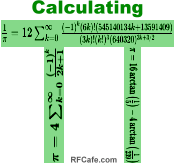Electronics & Technology
- See Full List of AI Topics -
 The concept of
π
as the ratio of a circle's circumference to its diameter has been recognized since
antiquity (see my article entitled "Rationalizing
Pi"). Early calculations of
π
were conducted using geometric and numerical methods long before modern
computing tools. Around
1900 BC, the Babylonians approximated
π
as 3.125, while the Egyptians, as evidenced by the Rhind Papyrus, calculated a value
of approximately 3.1605. The Greek mathematician Archimedes of Syracuse (287–212
BC) advanced these efforts by inscribing and circumscribing polygons around a circle,
calculating their perimeters to determine bounds for
π.
His approximation, which placed
π
between 3.1408 and 3.1429, was remarkably precise for his era. The concept of
π
as the ratio of a circle's circumference to its diameter has been recognized since
antiquity (see my article entitled "Rationalizing
Pi"). Early calculations of
π
were conducted using geometric and numerical methods long before modern
computing tools. Around
1900 BC, the Babylonians approximated
π
as 3.125, while the Egyptians, as evidenced by the Rhind Papyrus, calculated a value
of approximately 3.1605. The Greek mathematician Archimedes of Syracuse (287–212
BC) advanced these efforts by inscribing and circumscribing polygons around a circle,
calculating their perimeters to determine bounds for
π.
His approximation, which placed
π
between 3.1408 and 3.1429, was remarkably precise for his era.
The discovery of mathematical series allowed for further refinement. The Madhava-Leibniz
series, formulated by the Kerala mathematician Madhava around 1400 and independently
discovered by James Gregory and Gottfried Leibniz, expressed
π
as an infinite series:

However, its slow convergence made it impractical for high-precision computations.
In 1706, John Machin introduced an arctangent-based formula, allowing for faster
convergence. His formula,
 , ,
became the foundation for many subsequent calculations.
By the 19th century, calculus enabled mathematicians to derive additional series
for pan
π.
William Shanks, for instance, manually calculated
π
to 707 decimal places, though only 527 were correct. The advent of electronic computers
revolutionized
π-calculation
methods. In 1949, the ENIAC computer computed
π
to 2,037 decimal places in 70 hours using Machin's formula. By 1958, the IBM 704
mainframe extended
π
to 10,000 places, and by 1987, Fujitsu's VP200 reached over a million digits using
the Gauss-Legendre algorithm.
Today, the Chudnovsky algorithm, developed in 1988, dominates high-precision
π
calculations. This formula,
 , ,
converges exceptionally quickly, adding about 14 decimal places per term. It
is paired with highly optimized arithmetic techniques, such as Fast Fourier Transform
(FFT) multiplication, to handle the enormous numbers involved.
In 2021, a team at the University of Applied Sciences Graubünden in Switzerland
used a high-performance computing cluster to compute 𝜋 π to 62.8 trillion decimal
places. A year later, Japanese software engineer Emma Haruka Iwao used Google Cloud
infrastructure to extend this to 100 trillion places. These calculations required
months of processing and employed specialized tools such as Y-cruncher, which is
designed for extreme precision in numerical computations.
For smaller-scale applications, π can also be computed programmatically. Below is an example of Excel VBA code for
calculating
π
to a specified number of decimal places using the Leibniz formula:
Public Function CalculatePi(DecimalPlaces As Integer) As String
Dim k As Long
Dim pi As Double
Dim terms As Long
Dim sign As Double
Dim i As Long
Dim result As String
pi = 0
terms = DecimalPlaces * 100
sign = 1
For k = 0 To terms
pi = pi + (sign / (2 * k + 1))
sign = -sign
Next k
pi = pi * 4
result = Application.WorksheetFunction.Text(pi, "0." & String(DecimalPlaces, "0"))
CalculatePi = result
End Function
To use this code, open the VBA editor in Excel by pressing Alt + F11. Insert
a new module and paste the code. Close the editor and return to Excel, where you
can call the function in a cell, such as =CalculatePi(10), to calculate
π
to 10 decimal places. While this method illustrates the principle, it is not suitable
for computing
π
to millions or trillions of digits, as modern computations require advanced algorithms
and hardware.
 This content was generated by the ChatGPT
artificial intelligence (AI) engine. Some review was performed to help detect and
correct any inaccuracies; however, you are encouraged to verify the information
yourself if it will be used for critical applications. In some cases, multiple solicitations
to ChatGPT were used to assimilate final content. Images and external hyperlinks
have also been added occasionally. Courts have ruled that AI-generated content is
not subject to copyright restrictions, but since I modify them, everything here
is protected by RF Cafe copyright. Your use of this data implies an agreement to
hold totally harmless Kirt Blattenberger, RF Cafe, and any and all of its assigns.
Thank you. Here are the major categories. This content was generated by the ChatGPT
artificial intelligence (AI) engine. Some review was performed to help detect and
correct any inaccuracies; however, you are encouraged to verify the information
yourself if it will be used for critical applications. In some cases, multiple solicitations
to ChatGPT were used to assimilate final content. Images and external hyperlinks
have also been added occasionally. Courts have ruled that AI-generated content is
not subject to copyright restrictions, but since I modify them, everything here
is protected by RF Cafe copyright. Your use of this data implies an agreement to
hold totally harmless Kirt Blattenberger, RF Cafe, and any and all of its assigns.
Thank you. Here are the major categories.
Electronics & High Tech
Companies | Electronics &
Tech Publications | Electronics &
Tech Pioneers | Electronics &
Tech Principles |
Tech Standards
Groups & Industry Associations |
Societal Influences on Technology
|










 ,
, ,
,
